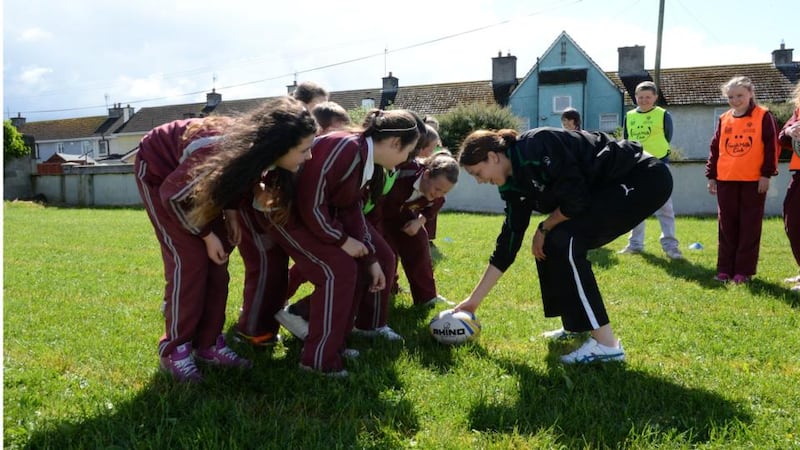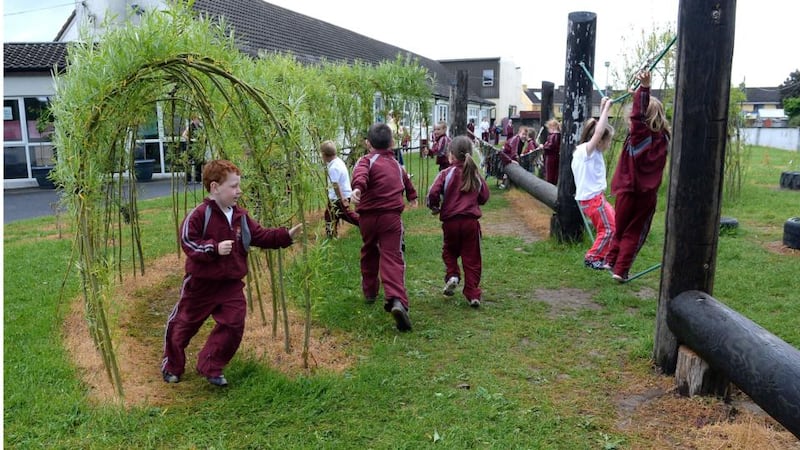Irish children are finding it difficult to stay slim. A delegation from the Irish Nutrition and Dietetic Institute recently told the Oireachtas that Irish children are now the fifth heaviest in Europe. They are relentlessly targeted by junk-food ads, eat too many processed foods and are lured by technology that leaves them increasingly sedentary. While the Government has failed to siphon off funds to treat overweight children, schools are becoming more proactive in dealing with a problem they are seeing every day.
Coill Dubh primary school, near Naas in Co Kildare, was concerned about national obesity trends and decided to get its pupils to exercise more, well before a lack of activity could become a problem.
Looking out of a staffroom window that overlooks the playground, the teachers had noticed that some of the children had stopped playing. They were sitting around talking or wandering the yard. Games like hopscotch and skipping were dying out, and the initiative to start a game of football was dwindling.


“For whatever reason after third class they stopped playing games, especially the girls,” says Joe Leacy, the principal of the seven-teacher, 130-pupil school, which was built on the edge of the Bog of Allen in 1956 for the children of Bord na Móna workers.
“They are definitely less active than previous generations, maybe because they are growing up in a digital age. We did a survey in maths class about screen time, and some of the children are spending four to six hours in front of a screen in the evenings.”
Coill Dubh's staff are exceptionally sporty. Among the teachers, Jen Leacy has earned 13 caps for Ireland women's rugby, Declan Coulter has played for Ireland in the Hurling International since 2007, Ciara Mooney plays camogie with Kildare senior champions and Helen Coyne has represented Ireland in the World Tug of War Championship.
With such a strong interest in sport themselves, the teachers were concerned by what they saw in the school yard and decided to improve their physical-education provision. In the past six months they also began applying for an Active School Flag from the Department of Education. To earn the flag, the school must evaluate itself in 15 areas and commit to making at least one improvement in each.
Extracurricular activities
They identified extracurricular activities as something they could work on, and set up a cross-country running league and hurling and camogie classes twice a week after school.
Another area of focus was the yard itself. To encourage the children to play, they bought two big buckets that they filled with toys to leave out at break time. “We bought things like balls, hula hoops, skipping ropes and spacehoppers, and we noticed the difference straight away,” says Evanna Linehan, who is co-ordinating the push to get the Active School Flag.
The children, represented by the student council, decided what toys to buy. Clearly part of a school that likes to give children a sense of ownership, the student council is elected every year after a full campaign, complete with posters and stump speeches, at the end of which real voting booths are dragged from storage for the pupils to cast their ballots.
As at most schools around the State, funding has not been available for improvements, but Joe Leacy has found what he needs elsewhere.
“If it is something you see as a priority, you will find a way to make it happen. You just have to look for opportunities. For example, the milk scheme is working in conjunction with the FAI, and we got a set of 30 soccer balls, collapsible nets, bibs and cones from them.”
Crafted playground
The community is well served with sports facilities, and the school is tapping into them. The local rugby club provides the pupils with a full set of tags and balls, and the GAA club supplies hurls and helmets.
Coill Dubh has also created a crafted playground. Beth Murphy, an artist from Willow Wonder, built a willow tunnel, two beehive “chat rooms” and an outdoor willow classroom that was partly funded by the Artist for a Day scheme.
Joe Leacy also secured a grant from the Crafts Council of Ireland for an artist to teach the children how to weave the colourful hammocks that now hang in the playground.
When the children are let loose at break time, bodies pile into the hammocks and tear through the willow tunnel – the healthy pandemonium you would expect from a children’s playground, and a good sign that moves to encourage the children to keep active are working.
Coill Dubh has just completed its Active School week – a requirement to apply for the Active School Flag.
The packed schedule included a basket- ball league, a scavenger hunt, dance classes – culminating in a flash mob for surprised parents at the school gate – a high-jump lesson from the local athletics club, a “run a mile with a smile” event and a traditional sports day.
Several sporting figures came in to speak to the children, including the former Kildare goalie Shane McCormack, the two-time Olympic runner David Matthews and Mary Louise Reilly of the Irish women's rugby team, who brought with her the RBS 6 Nations trophy from their historic Grand Slam win.
“After seeing how good people are to come in this week, I’m really hopeful of getting more help from outside sporting agencies,” says Evanna Linehan. “It really sparks enthusiasm for sport in children, and it is good for them to have healthy role models.”







